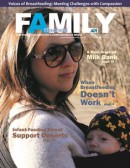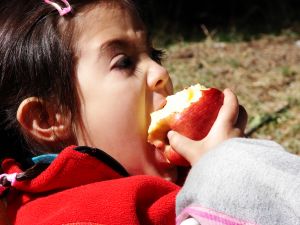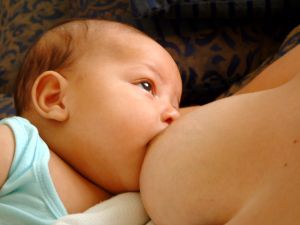New Magazine Issue Advocates for Increased Support of Compassionate Infant-Feeding Choices
 In honor of the millions of women who have come together throughout history to support one another in motherhood, Attachment Parenting International (API) is pleased to announce the latest edition of Attached Family magazine. This double “Voices of Breastfeeding” issue spotlights both the cultural explosion of breastfeeding advocacy as well as the challenges still to overcome.
In honor of the millions of women who have come together throughout history to support one another in motherhood, Attachment Parenting International (API) is pleased to announce the latest edition of Attached Family magazine. This double “Voices of Breastfeeding” issue spotlights both the cultural explosion of breastfeeding advocacy as well as the challenges still to overcome.
“This issue of the magazine has been a long time in the making,” said Rita Brhel, Editor of the Attached Family and API Publications Coordinator. “We wanted to create a resource that is helpful to all mothers, both those who were able to breastfeed their babies and those who were unable to.”
The “Voices of Breastfeeding” edition of Attached Family is divided into an “Advocating for Acceptance” issue that identifies the ever-growing movement of mothers inspired to campaign for society’s embrace of breastfeeding, and a “Meeting Challenges with Compassion” issue that recognizes that there are circumstances when breastfeeding is difficult, if not impossible, highlighting the importance of empathetic support for all infant-feeding choices.
“Ideally, I would have liked to have breastfed all three of my children,” Brhel said. “But Attachment Parenting International supports parents in all walks of life, including mothers who are unable to breastfeed, and I was able to learn how to meet my child’s attachment needs through sensitive responsiveness beyond breastfeeding.”
This edition of Attached Family was also made in appreciation of longtime magazines like Mothering, New Beginnings and Breastfeeding Today, which paved the way to widespread support for breastfeeding and Attachment Parenting conversations among mothers, and now fathers, and by extension, contributing to the breastfeeding movement that eventually influenced the research and medical communities.
“API is pleased to give a voice to our breastfeeding struggles, those related to society’s acceptance as well as those shared by mother and baby,” said Samantha Gray, Executive Director of Attachment Parenting International. “Emphasizing healthy attachment and relationship, it is natural that we speak up collectively to further advocacy efforts and gather together regularly to give personal support. Our contributors, led by Rita’s editorial vision and passion for breastfeeding support, have captured that perspective in this double issue.”
Scattered throughout the “Voices of Breastfeeding” edition of Attached Family are parent stories, project highlights and additional resources from around and beyond API, as well as the following features:
· “The Real Breastfeeding Story” detailing exactly how far industrial society has come in accepting breastfeeding, yet also how far we have yet to go, which includes a look at “Extended Nursing Around the World”
· “When Breastfeeding Doesn’t Work” explains the hard decisions some mothers made regarding their infant-feeding choices
· An interview with Katrina Pavlik, founder of “Breastfeed, Chicago!” and an accompanying photo essay of breastfeeding families in Chicago, Illinois, USA
· “Nature’s Case for Breastfeeding” featuring Attachment Parenting researcher Jeanne Stolzer from the University of Nebraska, USA
· A recap of the past century’s infant-feeding landscape in “The History of Formula Use”
· API’s debut of the Parent Support Deserts project with a presentation of infant-feeding support deserts within the United States
· “Why Relationship with Your Baby Matters” by API’s Knowledge Base Coordinator Art Yuen
“This edition of Attached Family continues API’s goal of providing research-backed information in an environment of respect, empathy and compassion in order to support parents in making decisions for their families and to create support networks in their communities,” Brhel said.
API thanks cosponsors of this special edition of Attached Family: Arm’s Reach Concepts, Katie M. Berggren, Green Child Magazine, Momzelle and The Infant-Parent Institute for their generous contributions.
Access this double issue free of charge with API’s free membership.
 When I was pregnant for the first time, I wasn’t sure what I would do and I was actually a little afraid of committing to breastfeeding and being my child’s sole source of sustenance.
When I was pregnant for the first time, I wasn’t sure what I would do and I was actually a little afraid of committing to breastfeeding and being my child’s sole source of sustenance. My experience with weaning my daughter was very successful and non-traumatic, which was a good thing since I found it hard to imagine how I would ever refuse her.
My experience with weaning my daughter was very successful and non-traumatic, which was a good thing since I found it hard to imagine how I would ever refuse her. When my sister was a baby, I remember my mom had a food mill at the table and she would feed the same food to my sister that we ate for supper. It seemed easy to me, at four years old.
When my sister was a baby, I remember my mom had a food mill at the table and she would feed the same food to my sister that we ate for supper. It seemed easy to me, at four years old. At two years old, my son Ezra was a happy child, who seems to handle the frustrations of becoming socialized and civilized with amazing ease. If things got to be too much for him, he sought out momentary comfort at his mother’s breast, his tears were dried, tantrums were avoided, and hurts were healed.
At two years old, my son Ezra was a happy child, who seems to handle the frustrations of becoming socialized and civilized with amazing ease. If things got to be too much for him, he sought out momentary comfort at his mother’s breast, his tears were dried, tantrums were avoided, and hurts were healed.